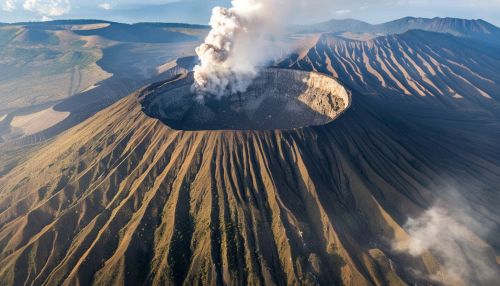Stratovolcano
Introduction
A Stratovolcano, also known as a composite volcano, is a conical volcano built up by many layers (strata) of hardened lava, tephra, pumice, and volcanic ash. Unlike shield volcanoes, stratovolcanoes are characterized by a steep profile and periodic, explosive eruptions. The lava that flows from stratovolcanoes tends to be viscous; it cools and hardens before spreading far. The magma forming this lava is often felsic, having high-to-intermediate levels of silica (as in rhyolite, dacite, or andesite), with lesser amounts of less-viscous mafic magma.


Formation
Stratovolcanoes are formed by the accumulation of material erupted through the volcano's vent. Each eruption, regardless of its nature (explosive or effusive), contributes to the formation of the volcano. Explosive eruptions produce pyroclastic material, including ash, bombs, and blocks that are ejected from the vent and can travel a significant distance before settling around the vent. Effusive eruptions produce lava flows that are initially very hot and fluid. As they flow from the vent, they cool and solidify, creating a new layer on the volcano's surface.
Characteristics
Stratovolcanoes are typically steep-sided, symmetrical cones of large dimension built of alternating layers of lava flows, volcanic ash, cinders, blocks, and bombs and may rise as much as 8,000 feet above their bases. Some of the largest stratovolcanoes are over 10,000 feet in height above sea level. The small cone-shaped volcanoes (cinder cones) that build up around the main vent are considered to be parasitic cones.
Eruptions
Stratovolcanoes are known for their explosive and destructive eruptions. The high viscosity of the magma in these volcanoes prevents gas from escaping from the magma. When the pressure of the gas becomes too great, an explosive eruption can occur. These eruptions can produce pyroclastic flows, lahars, and volcanic ash that can travel many kilometers from the volcano.
Distribution
Stratovolcanoes are found around the world, but they are most commonly found on the edges of the Pacific Plate, a region known as the Ring of Fire. This area is home to 75% of the world's active volcanoes. Other regions with stratovolcanoes include the Mediterranean, East Africa, and the Atlantic Ocean (the Canary and the Cape Verde islands).
Notable Stratovolcanoes
Some of the most famous stratovolcanoes include Mount Fuji in Japan, Mount Vesuvius in Italy, and Mount St. Helens and Mount Rainier in the United States. These volcanoes have all had major eruptions in the past and continue to be monitored for future volcanic activity.
Hazards
The hazards associated with stratovolcanoes are varied and can be deadly. Pyroclastic flows, which are fast-moving clouds of hot gas and volcanic matter, can destroy everything in their path. Ash fall can cause roofs to collapse, contaminate water supplies, and disrupt the operation of machinery. Lahars, which are mudflows caused when volcanic ash and debris mix with water, can bury entire towns.
